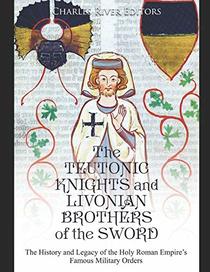Pope Urban II proposed a Crusade to the Holy Land to crush the Infidels (Islamic soldiers). From 634 CE, when the Muslims took over the Holy Lands and squabbling began over pilgrimage rights for Jews and Christians. In the 11h century, when the Seljuk-Turks invaded and created an empire in Mesopotamia, Syria, Palestine, and most of Iran, the concern over visiting holy sites for Christians and Jews moved into a higher gear.
Pope Urban responded with his call for a Crusade against the Turks and Muslims. The pope promised salvation to anyone fighting the barbarians. The People's Crusade was a bust; the Muslims speedily dispatched them to the next world. When the 1st Crusade arrived; the Crusaders butchered everyone, even those they promised to spare. The Second Crusade was led by monarchs with 50,000 soldiers. They were crushed by larger Muslim troops.
The Teutonic Knights --
The monks from the Order of Knights of the Hospital of Saint John of Jerusalem, commonly known as the Knights Hospitaller, or the Order of Saint John, was created in 1192 in Acre, Kingdom of Jerusalem. Originally, they were a medieval and early modern Catholic military order, offering hospital care to pilgrims (and later to anyone). They started as a small voluntary and mercenary military, to protect Christians in the Holy Land and later the Baltics. Before long, the Teutonic Knights took to the forcible conversion of the Persian pagans.
Livonian Brothers of the Sword --
The Livonian Brothers of the Sword was a Catholic military order established by Albert, the third bishop of Riga, in 1202. Pope Innocent III sanctioned the establishment in 1204 for the second time. The membership of the order comprised German "warrior monks" who fought Baltic and Finnic pagans in the area of modern-day Estonia, Latvia, and Lithuania.
***
Initially, these two groups were separate; later they would merge. From the records in this book, it is obvious that the men may have taken vows of chastity and poverty, but they were not considered the important thing. It was more important to gather lands and power. They also were cruel in how they 'Christianized" the pagans they met. They offered baptism at the end of a sword. These two groups seemed more intent on gaining power through wars than anything else. After all, the pope was thousands of miles away, and 'what he didn't know couldn't hurt them.'
After reading this, I have no illusions about why Eastern countries pale at the mention of a Crusade. The men outlined in this book were shockingly violent and dishonorable.
Pope Urban responded with his call for a Crusade against the Turks and Muslims. The pope promised salvation to anyone fighting the barbarians. The People's Crusade was a bust; the Muslims speedily dispatched them to the next world. When the 1st Crusade arrived; the Crusaders butchered everyone, even those they promised to spare. The Second Crusade was led by monarchs with 50,000 soldiers. They were crushed by larger Muslim troops.
The Teutonic Knights --
The monks from the Order of Knights of the Hospital of Saint John of Jerusalem, commonly known as the Knights Hospitaller, or the Order of Saint John, was created in 1192 in Acre, Kingdom of Jerusalem. Originally, they were a medieval and early modern Catholic military order, offering hospital care to pilgrims (and later to anyone). They started as a small voluntary and mercenary military, to protect Christians in the Holy Land and later the Baltics. Before long, the Teutonic Knights took to the forcible conversion of the Persian pagans.
Livonian Brothers of the Sword --
The Livonian Brothers of the Sword was a Catholic military order established by Albert, the third bishop of Riga, in 1202. Pope Innocent III sanctioned the establishment in 1204 for the second time. The membership of the order comprised German "warrior monks" who fought Baltic and Finnic pagans in the area of modern-day Estonia, Latvia, and Lithuania.
***
Initially, these two groups were separate; later they would merge. From the records in this book, it is obvious that the men may have taken vows of chastity and poverty, but they were not considered the important thing. It was more important to gather lands and power. They also were cruel in how they 'Christianized" the pagans they met. They offered baptism at the end of a sword. These two groups seemed more intent on gaining power through wars than anything else. After all, the pope was thousands of miles away, and 'what he didn't know couldn't hurt them.'
After reading this, I have no illusions about why Eastern countries pale at the mention of a Crusade. The men outlined in this book were shockingly violent and dishonorable.




